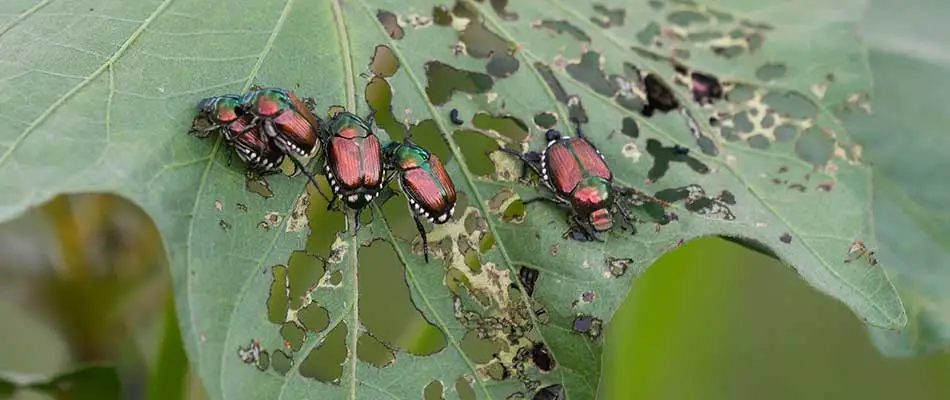If you start to see holes in the leaves of your landscape plants and notice iridescent flashes of flying insects, it is highly probable that your landscape plants, shrubs, and trees are falling victim to the pesky Japanese beetle. This invasive bug eats the leaves and flowers off of your plants, destroying the beauty of your landscaping and taking your investment with them.
Learn how you can get rid of Japanese beetles in central Iowa areas such as West Des Moines, Des Moines, Ankeny, and the surrounding cities.
Pesticides are the most effective way to get rid of Japanese beetles.

As these beetles begin to emerge from the soil after pupating, usually in late June to mid-July, they begin to eat your plants. If you have applied a preventative treatment, then this should help to control their population. Curative treatment may also be required, particularly if the invasion is bad or the beetles stay around for a while. Generally, it is recommended to apply the treatment once or twice per season.
At A+ Lawn & Landscape, we use a product called Bifenthrin to get rid of these beetles. This product is used for Japanese beetles, but can also prevent other pests such as ticks, fire ants, spiders, yellow jackets, flies, fleas, termites, and more. Each treatment will be effective for about 30 days or so. If the beetles are present on your plants, the spray will kill them on contact, thus protecting any part of the landscape that has not yet been damaged by these voracious pests.
Install plants in your landscaping that are less likely to attract these beetles.
While Japanese beetles can and will destroy almost any type of plant, tree, or shrub, there are certain types that attract them more than others. These insects seem to love roses, as well as hibiscus, fruit trees, Crape myrtle, Japanese maple, birch, and more.

If you want to try and naturally control these beetles somewhat, along with the aid of insecticides, consider installing plants in your landscape that may be less likely to attract them such as:
- Boxwood
- Burning bush
- Hemlock
- Forsythia
- Holly
- Spruce
- Lilac
Another plant that can be used to "trap" the beetles is geranium flowers. They are attracted to the flowers and will eat them, but the flowers have a substance in them that will paralyze the bugs and make them an easier target for predators.
Keep in mind, these plants are not guaranteed to repel Japanese beetles--only potentially deter them from destroying the landscape.
If you want an effective method, then yearly Japanese beetle control treatments are the best way to protect your landscape.
Do you want to prevent Japanese beetles from destroying your landscape plants? Call us for a treatment.
For more than three decades, the team at A+ Lawn & Landscape has worked to protect and care for landscapes across central Iowa, shielding them from common threats such as Japanese beetles. If you want to prevent your residential or commercial landscape plants from being destroyed, we can help. Call us at (515) 289-2020 to set up a treatment.






Comments (0)
Thanks for your comment!
Thanks for your feedback! Your comments have been successfully submitted! Please note, all comments require admin approval prior to display.
Error submitting comment!
There is a problem with your comment, please see below and try again.